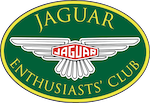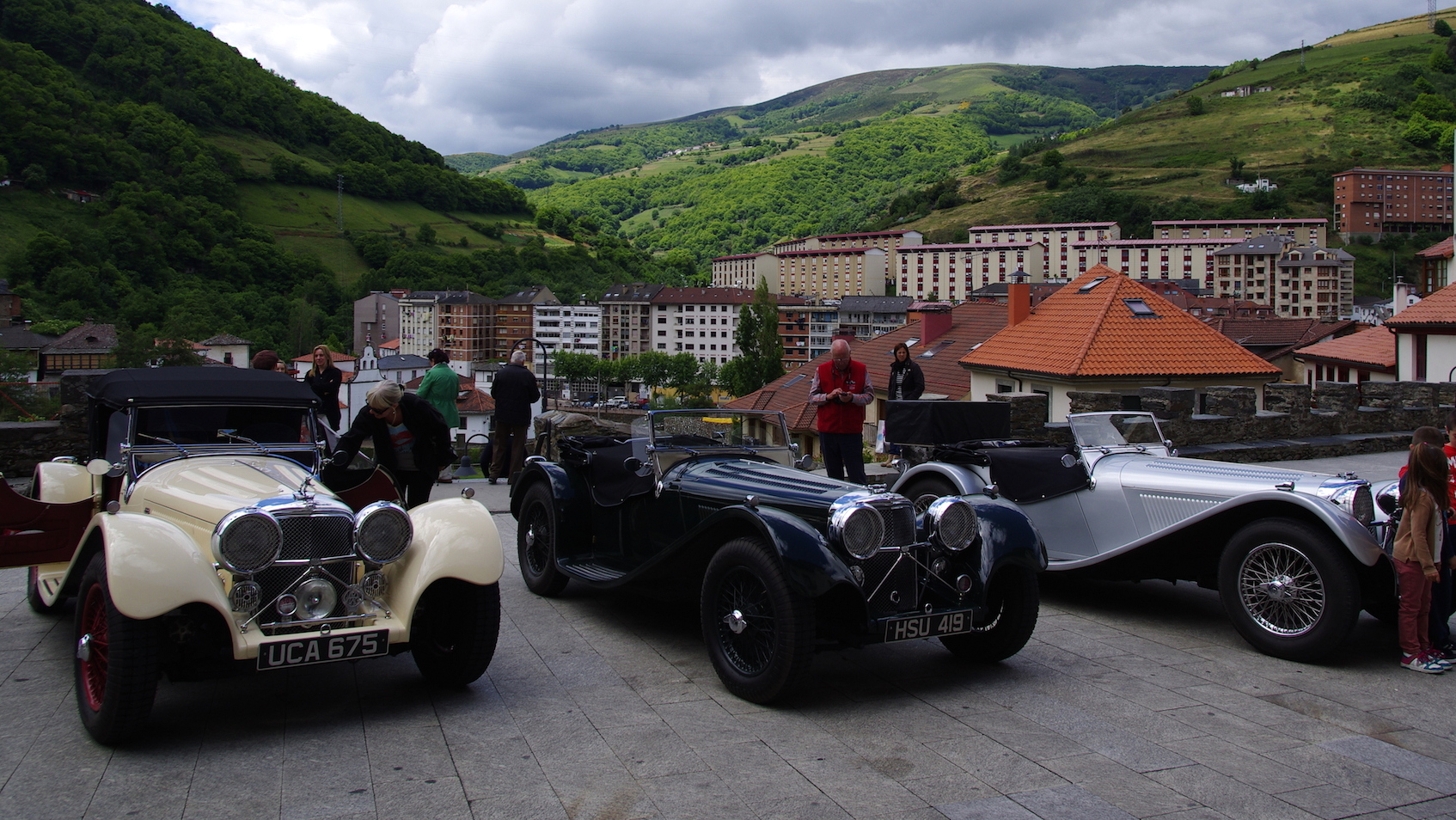Grace and pace, but not much space for luggage. Nevertheless a Suffolk SS100 is meant to be driven and, this June, I travelled to Spain a second time for a touring holiday with seven other Suffolk SS100’s. Organised and escorted by Classics on the Road, last year’s tour of Rioja and Cantabria was such a success that Roger Williams of Suffolk Jaguar invited them to plan another, longer trip, this time following the pilgrims’ trail to Santiago de Compostela in Galicia and then south to Portugal. Six out of the eight SS100’s from last year joined again, with two first-time travellers.
In contrast to the costas and southern Spain, the north west has a landscape of hills and mountains that is lush, green and unspoiled, mainly because it has one of the heaviest average rainfalls in Europe. Sure enough, for the second year running, it was pouring down as we disembarked from the ferry in Santander to be greeted by Diego and Juan, our two guides. Diego and Juan are Classics on the Road. Hoods quickly up, we drove about 35 miles to a chalet-style hotel in the foothills of the Picos de Europa, the mountainous range in the heart of northern Spain.
Sadly, this first night, we were not able to stay in the same hotel as last year, part of a spectacular monastery which holds in its collections the oldest piece of writing in the Spanish language; it had since gone bankrupt. The economic depression in Spain is much worse than in the UK, with almost 25% unemployment (having reached almost 40% a year or two ago). I did wonder, therefore, whether the same fate might be awaiting our second hotel this year, the luxurious, 5-star Palacio de Luces near the coast; we were the only guests, outnumbered by staff.
We arrived there, still in heavy rain, having visited an old mine-working with huge caves containing the most spectacular stalagmites and stalactites anywhere in Europe; that’s official, not just my hyperbole. They are delicate and fern-like, with tiny fronds of crystal growing in all directions, not just up and down. They look like chandeliers and apparently the only other place in the world with similar formations is a cave in Australia.
Day 3 and the rain cleared up; we had beautiful weather for the rest of the two weeks. Today we visited an ancient royal summer palace dating from the 9th century. Only two storeys with two rooms about 20 feet by 60 feet and two tiny second chambers, but a substantial and important building for its time. This was the last Christian stronghold in Spain after it was invaded by the Moors (muslims), and the place from which the Reconquest began some 200-300 years later.
Day 4 and we arrived in Santiago de Compostela, the destination for millions of pilgrims from all over Europe for more than a thousand years. We stayed in the best hotel, attached to the monastery of San Francisco (St Francis) right in the centre by the cathedral and the cobbled central square. The centre of Santiagio is for pedestrians only, but we were ushered right into the middle of the square for photographs. Eight SS100’s in such surroundings attract a lot of attention and help the local tourist trade so, almost everywhere we went, the local police were happy to escort us into the centre of town, ignore parking restrictions and even watch over our cars while we went off for lunch.
Santiago was our base for a couple of days while we went on a boat trip through mountain gorges and visited the sights and cafes of Santiago. We then left to drive down the coast into Portugal, stopping en route at a wonderful cathedral and restaurant on top of a hill with spectacular views over the sea, river Lima and town of Viana do Castelo.
Then into Portugal and a rude shock. I don’t wish to offend but the standard of driving in Portugal really is the worst in Europe. Having been shown every courtesy in Spain, within half an hour of crossing the border into Portugal we were all terrified; two of us had nearly been forced off the road or into the barrier for serious accidents at 70mph and everyone had noticed how much more aggressively the locals drive. Luckily, despite some very near misses (just inches away) we did all escape without a scratch, and were much more wary of other drivers for the rest of our stay.
Porto was our base for the next couple of days, including a visit to Grahams’ port cellars. The visit ended with a tasting, of five different ruby, tawny and vintage port wines (‘hic’…) followed by lunch with white port and tonic, a surprisingly good combination, and yet more wine. Fortunately it was only a very short drive back to the hotel because I would not like to have been stopped for a breathalyser.
Day 8 was a drive up the Douro valley, the home of port wine, and back into Spain to Leon. This was the longest day’s driving, over 200 miles, so much of the planned route was to be via motorway or dual carriageway. Motorway driving in a Suffolk SS100, with almost no wind protection, is actually very wearing, so I chose to leave the group and go a different route for the first part of the day, setting off a couple of hours earlier and following the old, twisty road along the river valley. I’d agreed with Diego and Juan that I would meet everyone at 11.30 in a particular village on the river bank. As I only had a basic map and would be driving unescorted, the rest of the group wished me luck and probably thought they would never see me again; certainly there were no others willing to join me. However I definitely made the right choice; it was a wonderful drive along quiet, mountainous roads with almost no other traffic and brilliant scenery. Fortunately my sense of direction is OK so I was indeed waiting with a cup of coffee when everyone else arrived in the designated village.
Leon is a great city, with reputedly the best parador (hotel) in Spain, one of only two with 5 stars, and a cathedral renowned for its early medieval stained glass windows. A local guide showed us around. Her English was excellent but I did once gently suggest to her, when she was explaining that three balls hanging from the door was the sign of a “pawn shop”, that perhaps she should say “pawnbrokers” as the other phrase might be misunderstood for another kind of establishment altogether!
Days 9 and 10 were back in the Picos de Europa, amongst the mountains, lakes and local farm animals with herds of sheep, cattle and goats all freely roaming the roads. I was leading the group at one point when I had to stop for a large bull with his harem of cows in the middle of the road. We looked at each other for about thirty seconds before I decided to edge my car slowly around behind him but, just as I was starting to move, he lifted his tail and deposited a large pile just about where my head would have been; I decided to wait for another thirty seconds or so.
The 11th and final day was in Santander – home town of the late Severiano Ballesteros – wandering along the beaches, amongst the markets and generally relaxing before finally catching the evening ferry back to Portsmouth.
Overall another fantastic holiday, brilliantly organised and supported by Classics on the Road. Diego and Juan had planned the routes meticulously for the scenery, driving and sights. They organised coffee stops, three-course lunches and three-course dinners almost every day in the best restaurants, staying in top-notch hotels. Their English is superb and they looked after us every step of the way, leading the group and ready to stop or help if anyone had any problem, whether mechanical or medical. We suggested to them at dinner on the last evening that, if they propose another trip next year perhaps heading east towards the Pyrenees and Catalonia, they are pretty much guaranteed at least half a dozen takers!
Richard Gibby
[youtube=http://youtu.be/Ct0t3hj9F7E]



